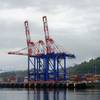Local and state dignitaries convened on the Monmouth County waterfront to take part in the christening of the Gladding-Hearn built M/V Seastreak New Jersey, a 141-ft. (42.9-m), 400 passenger high speed catamaran which will provide daily commuter service from Atlantic Highlands, and Highlands, N.J., to Pier 11 (Wall Street) and East 34th Street in Manhattan.
According to Geoffrey Ede of SeaStreak America, Inc., Seastreak New Jersey and its sister ship Seastreak New York are the fastest diesel powered ferries in the New York Harbor today with service speeds of approximately 45 mph. Our outstanding commuter service into New York will play an important role in the lives of many New Jerseyeans who travel to Manhattan.” Gladding-Hearn Chairman George Duclos joined in welcoming the addition of the new vessel to his customer’s fleet at the christening ceremony at the Atlantic Highlands Municipal Marina, Pier 6.
Preston Gladding’s Dream: The People
It had been Preston Gladding’s dream to own and operate a small commercial shipyard where he would be personally responsible for designing and building vessels for customer operators, where the naval architect would be “a part of the whole job . . . from initial prospect contract to final delivery at the owner’s pier.” Preston Gladding succeeded in his dream. Working with Richard Hearn and George Duclos, he created a legacy of excellence in custom shipbuilding, which continues to this day.
Gladding-Hearn Shipbuilding was organized in 1954 by Preston R. Gladding (B.S. Nav. Arch. MIT 1941) and Richard C. Hearn (B.S. Accounting, Bryant 1942). A 22-year-old George R. Duclos joined the company that same year, and became its vice president and contract manager in the year following. The first Gladding-Hearn vessel was delivered in early 1956, a 47 ft. (14.3-m) steel dragger, Northstar, purchased by a Point Judith, R.I. fisherman – the now famous marine artist John Sisson. During the remainder of the1950s, 60s and 70s the Gladding-Hearn business flourished as it became one of America’s premier builders of small, custom steel fishing boats, tugs and pilot boats. In the early 80s, after nearly 250 successful vessels, Preston Gladding and Richard Hearn sought retirement, and the ownership of the business was transferred to the Duclos Corporation with George Duclos as President and his wife Pauline as Treasurer. Their son, John (B.S. Mar E. U.S.M.M.A., M.S. Nav. Arch. U. Mich. 1982) joined the business in 1984, and son, Peter (B.E. Mech. E. U. Mass. 1987) in 1987. In 1999, George took on the title of Chairman and Chief Executive Officer, and sons, John and Peter, were named as co-presidents, with their mother, Pauline, continuing as treasurer and now also vice president. Their sister, Carol Duclos Hegarty, joined the company as CFO.
The Gladding-Hearn/Duclos Shipyard
Since its establishment in 1955, Gladding-Hearn Shipbuilding has designed and built more than 320 commercial vessels at its Somerset, Mass. facility. There are 12 vessels in various stages of construction, and the contract for shipyard vessel hull 341 has recently been finalized. The yard has a securely established reputation for the production custom quality, specialized craft for a variety of uses to its own, and customer specifications. In recent years Gladding-Hearn has established itself as one of the nation’s leading fast ferry builders. And, over the past four years the company has delivered more high speed ferries than all other U.S. fast ferry builders combined.
For the yard’s first three decades, its focus leaned toward tug boats, pilot and police boats, and a mix of other of specialty vessels. During this period, more than 100 tugs and a similar number of fishing and lobster boats, and more than 50 pilot boats were built for customers in the U.S. and abroad. Ellicott Machine dredges used Gladding-Hearn tugs. The first tractor tug built in the U.S. was a Gladding-Hearn design, a 1977 building for Wilmington Tug & Launch – the first of a three vessel series. Many customers were repeat buyers. The Delaware Bay Pilots and the Sandy Hook Pilots were each seven-time pilot boat purchasers. The Virginia Pilots purchased boats on five separate occasions, and the New York City Police Department purchased 13 vessels in a range of sizes. A new Chesapeake class of 53-ft. pilot boats is underway, with the first two boats to be delivered to the Virginia and Maryland pilots associations in October, and a third and fourth to the Tampa and Maryland pilots associations in 2003. These vessel types remain an important part of the production mix today, even though the glamour may be in fast ferries.
Upon the completion of licensing arrangements with International Catamaran Designs Pty, Ltd. (Sydney) (INCAT Designs) in 1984, the yard added the Philip Hercus designs for fast ferries, whale watch catamarans, and other high speed vessels, to its portfolio. Since then, Gladding-Hearn has built more than 28 passenger vessels, including 22 fast catamarans, of which ten have been delivered in the last 36 months. Recent deliveries have included two 92-ft. (28 m), 149 passenger harbor commuter vessels for Water Transportation Alternatives, which provides a Boston Logan Airport to Quincy service; three 121-ft. (37-m), 350 passenger “whale watch” vessels for long-time customer Boston Harbor Cruises; and two 141-ft. (42.9-m), 400 passenger, fast commuter vessels for Seastreak America, Inc. These last two vessels, Seastreak New York and the Seastreak New Jersey, were purchased to supplement an already existing New Jersey to Manhattan commuter operation which has been serviced by two earlier 300 passenger Gladding-Hearn built fast catamarans. Matters under discussion include follow-on orders for two additional 400 passenger fast ferries for Seastreak, and one or more large passenger/vehicle ferries for a to-be-established Great Lakes service.
Why the Duclos Shipyard “Works”
Several factors appear to contribute to the shipyard’s success. George Duclos has had more than 45 years of hands on shipbuilding in this shipyard. Overall, the management staff averages approximately 18 years. The naval architect, marine engineer skills of the yard senior management John and Peter Duclos facilitate the development of vessel designs attuned to customer described needs, and the delivery of boats which meet and exceed the customer expectations. The yard has well-paid, satisfied employees and a high employee retention rate. Walking through the yard on a winter afternoon, one is impressed in seeing men and women at purposeful work – work that they obviously enjoy.
The Duclos family principals are directly involved in each customer’s project. Family member contact is maintained throughout vessel design and construction, and up to and after delivery. A project manager with a thorough knowledge of the design and construction process serves as the focal point for the customer on all technical and contractual issues. The project manager administers the progress of the vessel, detailing that progress to the buyer. Forty-five years of experience has ingrained the importance of proper production planning in order to complete each project on time and at the highest level of quality. State-of-the-art computers, and the use of the critical path technique and project management software keep all projects on track. Computer based management programs are used to plan activities and key dates as well as to allocate personnel and resources. Progress is monitored and compared to a master schedule. Production teams meet on a daily basis to critique progress and plan for any unforeseen contingency. The engineering group is tasked with interpreting specification requirements for every component, dealing with the outside designers and maintaining a production schedule. The purchasing department schedules deliveries from more than 800 vendors.
Gladding-Hearn's in-house design capability is enhanced by teaming with outside design firms such as C. Raymond Hunt Associates and Propulsion Data Service, in Boston and Marblehead, and Bay Marine of Barrington, Rhode Island, as well as the already mentioned INCAT Designs. These teaming efforts provide the customer with the best in vessel design, with the optimization of vessel structure and outfit. And, this in turn can produce as a result, exceptionally attractive pricing.
Since 1995, Gladding-Hearn has contracted and managed three Defense Advanced Research Project Administration (DARPA) cooperative agreements, which are administered by the Maritime Administration (MarAd). This partnership with the U.S. government has enabled the company to develop new high-speed catamaran and ferry technology, implement new construction techniques and adopt advanced business systems and “best” practices. Program results have included the development of a new low cost, low wake, composite hulled catamaran, the design and implementation of a Zone Outfit Logic Technology (“ZOLT”) production management program involving modular ship construction principles, and the development and installation of new software programs to improve the shipbuilding process. In December 1998 the company opened a new 24,000 sq. ft., high cube fabrication facility that doubled its capacity for vessel deliveries.
In June 2000, the Massachusetts Maritime Academy awarded George Raymond Duclos an honorary Doctor of Public Administration in recognition of his lifetime of achievements and dedication to the maritime industry.
“You have been in the vessel repair and construction industry for more than half a century. . . .[Y]ou first found your sea legs by building, at age 12, your first 10-ft. boat, in your family’s basement. By 1948, you had your own boat repair business in Westport, Mass. In 1950, while working for Anchorage Plastic, in Warren, R.I., under the tutelage of Preston Gladding, you pioneered the design of fiberglass vessels. . . . Today, in Boston Harbor alone, there are more than half a dozen of your vessels plying the waters, transporting hundreds of thousands of passengers to their destinations. . . . You are respected throughout the maritime industry by the manner in which the Duclos Corporation operates.”
After having taken delivery of Salacia, a 145-ft. (44.1-m), 597 passenger, 36 knot, new building, Rick Nolan, Managing Director of Boston Harbor Cruises said, “This is our fourth Gladding-Hearn built catamaran, and Salacia is exceeding all of our expectations. We could not be happier with the quality of our Gladding-Hearn vessels – or our relationship with the Duclos Corporation.”
The preceding was submitted by H. Clayton Cook, Jr., B. S. Princeton University, LLB The University of Virginia. Mr. Cook commenced practice with Sullivan & Cromwell in New York City before joining the Pepper Hamilton firm in Philadelphia where he became partner in their Tax Department. He resigned from the Pepper firm to become General Counsel of the Maritime Administration where he was responsible for Merchant Marine Act of 1970 program implementation. Upon completing his government service, Mr. Cook joined Cadwalader, Wickersham & Taft as the partner responsible for that firm's Washington maritime practice. Mr. Cook continues in practice today as counsel to the Washington D.C. firm Bastianelli, Brown & Kelley, Chtd. His e-mail address is: [email protected].
Featured videos

Tracking Foreign Vessels Working in the U.S. Jones Act Market

Unlock Onboard Data Efficiencies

Inmarsat Enhances Service to Drive Digitalization
Subscribe for
Maritime Reporter E-News
Maritime Reporter E-News is the maritime industry's largest circulation and most authoritative ENews Service, delivered to your Email five times per week









